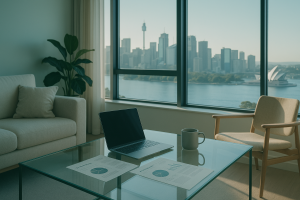Buying a property is a significant milestone, particularly in Sydney’s bustling real estate market. While most buyers are aware of the hefty price tag associated with purchasing a home, many are often unprepared for the array of hidden costs that accompany the process. Understanding these costs is crucial to avoid financial surprises and ensure a smooth buying experience. This blog post delves into the myriad expenses that Sydney property buyers need to consider, guiding you through the journey from start to finish.
5 Quick Points About Hidden Costs
- Stamp Duty: This government tax can be a substantial additional cost, often overlooked by first-time buyers.
- Legal and Conveyancing Fees: Professional fees for handling the legal aspects of the property purchase.
- Inspection Fees: Costs for building, pest, and strata inspections to ensure the property is in good condition.
- Loan Establishment Fees: Charges from lenders to set up your mortgage, including application fees and other administrative costs.
- Ongoing Costs: Includes council rates, utilities, and potential renovations or repairs that might be necessary.
Upfront Costs
1. Stamp Duty
Stamp duty is one of the most significant upfront costs when purchasing a property in Sydney. It is a state government tax based on the property’s purchase price, and it can amount to tens of thousands of dollars. The exact amount depends on various factors, including the property’s value, whether you are a first-time buyer, and if you qualify for any exemptions or concessions.
2. Legal and Conveyancing Fees
Legal and conveyancing fees cover the cost of hiring a solicitor or conveyancer to manage the legal aspects of your property purchase. These professionals ensure that the title of the property is transferred correctly, handle the contract of sale, and check for any potential legal issues. Fees can vary but typically range from $1,000 to $3,000.
3. Inspection Fees
Before finalizing the purchase, it’s essential to conduct thorough inspections to identify any potential issues with the property. Common inspections include:
- Building Inspection: Assesses the structural integrity of the property.
- Pest Inspection: Checks for termite damage and other pest-related issues.
- Strata Inspection: For apartments and units, this inspection reviews the strata records for any financial or maintenance concerns.
Each inspection can cost between $300 and $600, but they are crucial for avoiding future problems and negotiating the purchase price.
4. Loan Establishment Fees
When securing a mortgage, lenders often charge various fees to establish the loan. These can include:
- Application Fee: Typically ranges from $200 to $600.
- Valuation Fee: Usually between $200 and $400, this covers the cost of having the property professionally valued.
- Lenders Mortgage Insurance (LMI): If your deposit is less than 20% of the property’s value, you may need to pay LMI, which can be a substantial cost.
5. Deposit
The deposit is a significant upfront cost, generally around 10-20% of the purchase price. This amount is payable upon signing the contract of sale and secures the property for you. For a $1 million property, this means a deposit of $100,000 to $200,000.
Additional Costs During the Purchase Process
6. Mortgage Insurance
As mentioned, Lenders Mortgage Insurance (LMI) is required if your deposit is less than 20% of the property’s value. LMI protects the lender in case you default on the loan. The cost of LMI varies based on the loan amount and the loan-to-value ratio (LVR) but can easily add thousands to your expenses.
7. Mortgage Registration Fee
This is a fee charged by the state government to register your mortgage on the title of the property. In NSW, the mortgage registration fee is currently around $150.
8. Transfer Fee
Also known as a transfer duty, this fee is charged to register the transfer of property ownership with the state government. In NSW, the transfer fee is approximately $150.
Post-Purchase Costs
9. Moving Costs
Moving into your new home involves expenses such as hiring a removalist, purchasing packing materials, and possibly storage costs. Depending on the distance and the volume of your belongings, moving costs can range from a few hundred to several thousand dollars.
10. Utility Connections
Setting up utilities like electricity, gas, water, and internet in your new home incurs connection fees. Each utility provider may charge a different rate, but you can expect to pay around $50 to $200 for each service.
11. Council Rates and Strata Fees
Once you own the property, you will need to pay ongoing costs such as council rates and, if applicable, strata fees. Council rates are charged by the local government for services such as waste collection and road maintenance. Strata fees apply to apartments and cover the cost of building maintenance, insurance, and common area upkeep. These fees can vary widely based on the property and location.
12. Home and Contents Insurance
Insuring your new home and its contents is essential for protecting your investment. The cost of insurance depends on factors such as the property’s value, location, and the level of coverage you choose. Home and contents insurance can range from a few hundred to several thousand dollars per year.
13. Maintenance and Repairs
Maintaining your property is an ongoing cost that includes routine maintenance and unexpected repairs. It’s wise to budget for these expenses to ensure your home remains in good condition. Maintenance costs can vary but typically include items like gardening, painting, and minor repairs.
14. Renovations and Improvements
If you plan to make any renovations or improvements to your new home, these costs need to be factored into your budget. Renovations can range from minor cosmetic updates to major structural changes and can significantly impact your overall expenses.
5 FAQs about Hidden Costs of Buying a Property in Sydney
- What is stamp duty, and how is it calculated? Stamp duty is a state government tax based on the property’s purchase price. In NSW, it is calculated on a sliding scale, with higher rates applied to more expensive properties. Various online calculators can help you estimate the exact amount.
- Are inspection fees really necessary? Yes, inspection fees are crucial for identifying potential issues with the property. Skipping inspections can lead to costly repairs in the future and may affect the property’s value and safety.
- How can I reduce Lenders Mortgage Insurance (LMI) costs? To avoid or reduce LMI costs, aim to save a deposit of at least 20% of the property’s value. Alternatively, some lenders offer shared equity schemes or family guarantees that can help lower LMI.
- What are strata fees, and do I have to pay them? Strata fees apply to apartments and units and cover the cost of maintaining common areas and shared facilities. These fees are mandatory and vary based on the property’s location and amenities.
- Can I include moving costs in my mortgage? Some lenders may allow you to include moving costs and other associated expenses in your mortgage, but this depends on the lender’s policies and the terms of your loan. It’s best to discuss this with your mortgage broker or lender.
Conclusion
Understanding the hidden costs associated with buying a property in Sydney is essential for making informed financial decisions. From stamp duty and legal fees to inspection costs and ongoing expenses, being aware of these costs will help you budget effectively and avoid unexpected financial stress. By thoroughly researching and preparing for these expenses, you can navigate the property buying process with confidence and ensure a smooth transition into your new home.
Whether you’re a first-time buyer or an experienced investor, taking the time to understand and plan for these hidden costs is a critical step in achieving your property ownership goals. Armed with this knowledge, you’ll be better equipped to manage your finances and enjoy the exciting journey of purchasing a property in one of the world’s most vibrant cities.



